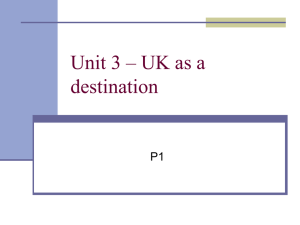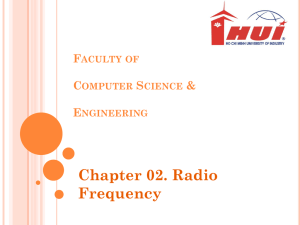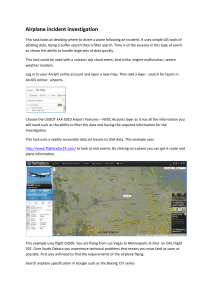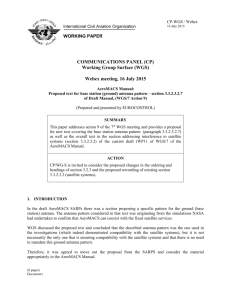Date: 30.03.2015
advertisement
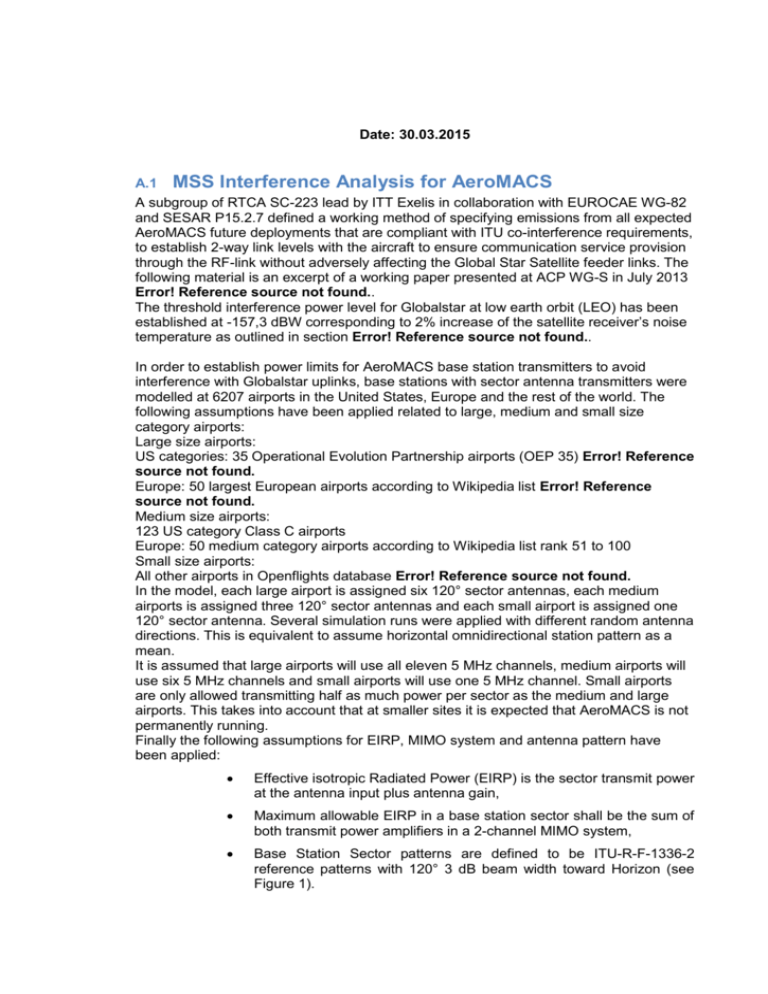
Date: 30.03.2015 A.1 MSS Interference Analysis for AeroMACS A subgroup of RTCA SC-223 lead by ITT Exelis in collaboration with EUROCAE WG-82 and SESAR P15.2.7 defined a working method of specifying emissions from all expected AeroMACS future deployments that are compliant with ITU co-interference requirements, to establish 2-way link levels with the aircraft to ensure communication service provision through the RF-link without adversely affecting the Global Star Satellite feeder links. The following material is an excerpt of a working paper presented at ACP WG-S in July 2013 Error! Reference source not found.. The threshold interference power level for Globalstar at low earth orbit (LEO) has been established at -157,3 dBW corresponding to 2% increase of the satellite receiver’s noise temperature as outlined in section Error! Reference source not found.. In order to establish power limits for AeroMACS base station transmitters to avoid interference with Globalstar uplinks, base stations with sector antenna transmitters were modelled at 6207 airports in the United States, Europe and the rest of the world. The following assumptions have been applied related to large, medium and small size category airports: Large size airports: US categories: 35 Operational Evolution Partnership airports (OEP 35) Error! Reference source not found. Europe: 50 largest European airports according to Wikipedia list Error! Reference source not found. Medium size airports: 123 US category Class C airports Europe: 50 medium category airports according to Wikipedia list rank 51 to 100 Small size airports: All other airports in Openflights database Error! Reference source not found. In the model, each large airport is assigned six 120° sector antennas, each medium airports is assigned three 120° sector antennas and each small airport is assigned one 120° sector antenna. Several simulation runs were applied with different random antenna directions. This is equivalent to assume horizontal omnidirectional station pattern as a mean. It is assumed that large airports will use all eleven 5 MHz channels, medium airports will use six 5 MHz channels and small airports will use one 5 MHz channel. Small airports are only allowed transmitting half as much power per sector as the medium and large airports. This takes into account that at smaller sites it is expected that AeroMACS is not permanently running. Finally the following assumptions for EIRP, MIMO system and antenna pattern have been applied: Effective isotropic Radiated Power (EIRP) is the sector transmit power at the antenna input plus antenna gain, Maximum allowable EIRP in a base station sector shall be the sum of both transmit power amplifiers in a 2-channel MIMO system, Base Station Sector patterns are defined to be ITU-R-F-1336-2 reference patterns with 120° 3 dB beam width toward Horizon (see Figure 1). Figure 1: ITU-R-F-1336-2 reference antenna patterns and mask Error! Reference source not found. Based on the analysis it is recommended that deployment of AeroMACS base stations observe the following emissions limitations: The total base station EIRP in a sector must not exceed: 39.4 dBm for elevation angles up to 1.5 degrees 39.4 dBm linearly decreasing (in dB) to 24.4 dBm for elevation angles from 1.5 to 7.5 degrees 24.4 dBm linearly decreasing (in dB) to 19.4 dBm for elevation angles from 7.5 to 27.5 degrees 19.4 dBm linearly decreasing (in dB) to 11.4 dBm for elevation angles from 27.5 to 90 degrees In addition the following requirement for the mobile stations is applied: The total mobile station EIRP shall not exceed 30 dBm These limitations include the following assumptions: (a) EIRP is defined as antenna gain in a specified elevation direction plus the average AeroMACS transmitter power. While the instantaneous peak power from a given transmitter can exceed that level when all of the subcarriers randomly align in phase, when the large number of transmitters assumed in the analysis is taken into account, average power is the appropriate metric. (b) The breakpoints in the base station EIRP mask are consistent with the elevation pattern of a +15 dBi peak, 120 degree sector antenna as contained in ITU-R F.1336-2. (c) If a station sector contains multiple transmit antennas on the same frequency (e.g., MIMO), the specified power limit is the sum of the power from each antenna. (d) No base station antenna down-tilt is applied in these assumptions. Higher sector average transmit power can meet these limitations if antenna pattern down-tilt is used. (f) Mobile station EIRP is based on full occupancy of transmit sub-carriers for 5 MHz bandwidth
